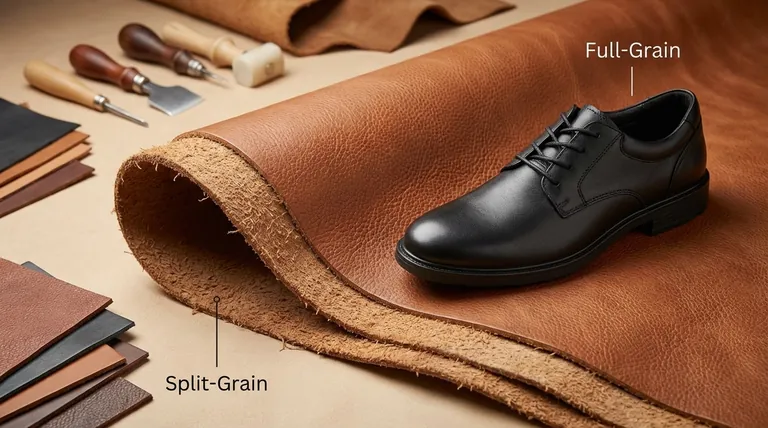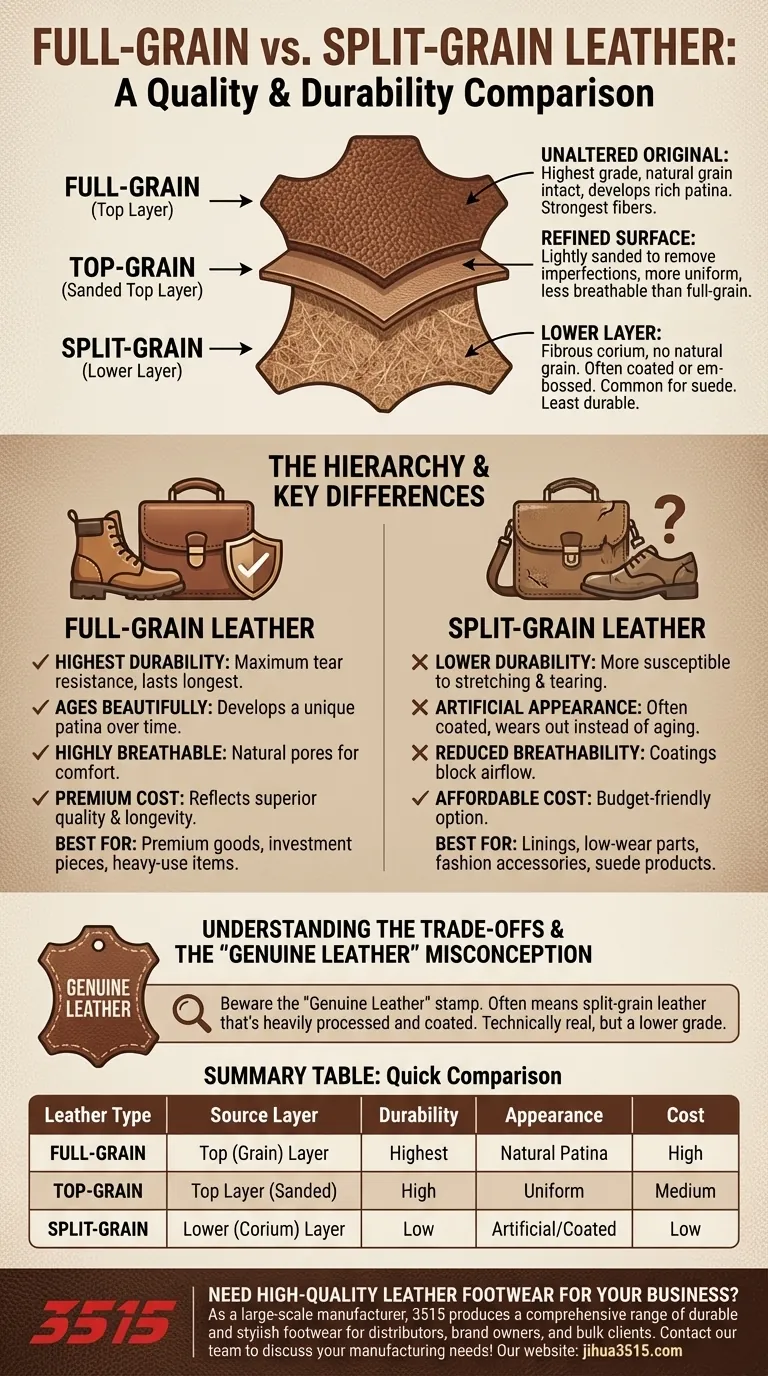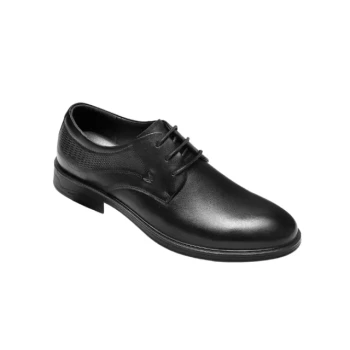In simple terms, split-grain leather is the lower, fibrous layer of an animal's hide that is left after the more valuable top layer has been "split" off. Compared to full-grain leather—which is the premium, unaltered outer layer of the hide—split-grain is significantly less durable, less dense, and does not possess the natural grain. It is often used for more affordable goods or is processed further to create materials like suede.
The critical distinction lies in the layer of the hide used. Full-grain represents the strong, unaltered outer surface, prized for its durability and aging potential, while split-grain is the weaker, inner layer, valued for its lower cost and versatility in specific applications.

The Hierarchy of Leather: From Hide to Final Product
To truly understand the difference, you must first visualize an animal hide as having two primary layers. The top layer is the grain, which is exposed to the elements and has dense, tightly-packed fibers. The bottom layer is the corium (or flesh side), which is looser and more fibrous. The quality of leather is almost entirely determined by which part of these layers is used and how it is processed.
Full-Grain Leather: The Unaltered Original
Full-grain is the highest grade of leather. It is made from the entire top layer of the hide without any sanding or buffing to remove imperfections.
Because the natural grain is left intact, it has the highest fiber strength and durability. Over time, it develops a rich patina, a desirable sheen that comes with use and age. Its main characteristics are unmatched strength and longevity.
Top-Grain Leather: The Refined Surface
Top-grain is the second-highest quality. It is also taken from the top layer of the hide, but it is lightly sanded and buffed to remove blemishes like scars or branding marks.
This process creates a more uniform and smoother appearance. While still very strong and durable, the sanding removes the strongest fibers, making it slightly less durable and breathable than full-grain. It will not develop the same character-rich patina over time.
Split-Grain Leather: The Lower Layer
Split-grain leather is what remains after the top-grain layer is split off the hide. It is the fibrous part of the corium and has no natural grain of its own.
Its surface is often an artificial one, either coated with a polymer or embossed with a grain-like pattern to mimic higher-quality leather. Suede is a common form of split-grain leather where the surface is napped to create a soft, fuzzy texture.
Key Differences at a Glance
The choice between these leather types has direct consequences for the final product's performance, appearance, and cost.
Durability and Longevity
Full-grain is the clear winner. Its tightly packed, vertically-oriented fibers from the grain layer provide maximum tear resistance and strength. Split-grain products are far more susceptible to stretching and tearing.
Appearance and Aging
Full-grain leather tells a story, displaying natural markings and developing a beautiful patina over its long life. Top-grain offers a more consistent look from day one. Split-grain, especially when coated, often looks artificial and will simply wear out rather than age gracefully.
Breathability and Comfort
The natural pores of full-grain leather make it highly breathable, contributing to comfort, especially in footwear. The finishing process of top-grain and the artificial coatings often applied to split-grain significantly reduce their breathability.
Cost
The hierarchy of quality directly reflects the cost. Full-grain is the most expensive due to its quality and lower yield from each hide. Top-grain is more accessible, and split-grain is the most affordable option.
Understanding the Trade-offs
Making an informed decision requires acknowledging that no single type is universally "best" without context. The goal is to match the material to the purpose.
The "Genuine Leather" Misconception
A common point of confusion is the "Genuine Leather" stamp. While it sounds reassuring, this term is often used for products made from split-grain leather that has been heavily processed and coated. It is technically real leather, but it represents one of the lowest grades in the quality spectrum.
When Split-Grain Makes Sense
Split-grain is not inherently a "bad" material; it is simply suited for different applications. It is an excellent choice for the linings of shoes, the sides and backs of furniture where wear is minimal, or fashion accessories where cost is a primary driver.
The Cost of Perfection
Full-grain leather's superior durability comes at a higher price and often requires a break-in period to become supple. Its natural markings are considered a mark of authenticity by connoisseurs, but some users may prefer the flawless, uniform finish of top-grain leather for a more formal aesthetic.
Making the Right Choice for Your Needs
Your final decision should be guided by your primary goal for the product you are buying.
- If your primary focus is maximum durability and longevity: Always choose full-grain leather, as it will outlast all other grades and improve with age.
- If your primary focus is a uniform, flawless appearance with good durability: Top-grain leather provides an excellent balance of quality, a clean aesthetic, and a more accessible price point.
- If your primary focus is affordability or a specific texture like suede: Split-grain leather is the appropriate choice, but be aware of its limitations in long-term wear and tear.
Understanding these fundamental differences empowers you to look beyond marketing terms and choose a product whose material truly aligns with your expectations for performance and value.
Summary Table:
| Leather Type | Source Layer | Durability | Appearance | Cost | Best For |
|---|---|---|---|---|---|
| Full-Grain | Top (Grain) Layer | Highest | Natural Patina | High | Premium Goods, Longevity |
| Top-Grain | Top Layer (Sanded) | High | Uniform | Medium | Balanced Quality & Aesthetics |
| Split-Grain | Lower (Corium) Layer | Low | Artificial/Coated | Low | Affordable Items, Linings |
Need High-Quality Leather Footwear for Your Business?
As a large-scale manufacturer, 3515 produces a comprehensive range of durable and stylish footwear for distributors, brand owners, and bulk clients. Whether you require the unmatched longevity of full-grain leather boots or cost-effective split-grain options for specific applications, our production capabilities cover all types of shoes and boots to meet your market demands.
Let us help you deliver value and quality to your customers. Contact our team today to discuss your manufacturing needs!
Visual Guide

Related Products
- Wholesale Comfort Leather Business Shoes with Dial Lacing System
- Classic Leather Derby Dress Shoes Wholesale & Custom Manufacturing
- Durable Leather Tactical Boots Wholesale & Custom Manufacturing for Brands
- Durable Leather Work Boots Wholesale Manufacturer & Custom Factory
- Wholesale Leather Work Boots with Customizable Wedge Sole for Brands
People Also Ask
- How does pull-up leather behave in shoes? It develops a unique, evolving patina.
- What are the key features of high-quality leather in shoes? Invest in Durability and a Perfect Fit
- Are sneakers acceptable in a business casual workplace? How to Choose the Right Style
- What should be known about genuine leather for shoes? Don't Be Misled by the Label
- How does top-grain leather differ from full-grain? Choose the Right Leather for Your Products



















